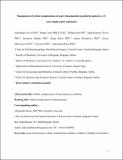Files in this item
Management of orbital complications of acute rhinosinusitis in pediatric patients : a 15-Year single-center experience
Item metadata
| dc.contributor.author | Trivić, Aleksandar | |
| dc.contributor.author | Cevik, Muge | |
| dc.contributor.author | Folić, Miljan | |
| dc.contributor.author | Krejovic-Trivić, Sanja | |
| dc.contributor.author | Rubino, Salvatore | |
| dc.contributor.author | Micić, Jelena | |
| dc.contributor.author | Stevanović, Goran | |
| dc.contributor.author | Milovanović, Jovica | |
| dc.contributor.author | Jotić, Ana | |
| dc.contributor.author | Barać, Aleksandra | |
| dc.date.accessioned | 2020-07-07T23:34:29Z | |
| dc.date.available | 2020-07-07T23:34:29Z | |
| dc.date.issued | 2019-07-08 | |
| dc.identifier | 260334979 | |
| dc.identifier | 496472ed-e38f-482d-a7bd-92e0fe65e756 | |
| dc.identifier | 31306351 | |
| dc.identifier | 85072746882 | |
| dc.identifier | 000509327000014 | |
| dc.identifier.citation | Trivić , A , Cevik , M , Folić , M , Krejovic-Trivić , S , Rubino , S , Micić , J , Stevanović , G , Milovanović , J , Jotić , A & Barać , A 2019 , ' Management of orbital complications of acute rhinosinusitis in pediatric patients : a 15-Year single-center experience ' , Pediatric Infectious Disease Journal , vol. Online First . https://doi.org/10.1097/INF.0000000000002414 | en |
| dc.identifier.issn | 0891-3668 | |
| dc.identifier.other | ORCID: /0000-0003-1133-3874/work/60196684 | |
| dc.identifier.uri | https://hdl.handle.net/10023/20217 | |
| dc.description.abstract | BACKGROUND: The major clinical dilemma managing acute rhinosinusitis (ARS) in pediatric population is distinguishing uncomplicated rhinosinusitis from a complicated bacterial ARS and orbital complications, the latter requiring antimicrobials and surgical intervention. However, factors associated with severe orbital complications and the optimum management strategy remains controversial. The objectives of this study were to characterize the clinical outcomes of children with orbital complications of ARS and to identify risk factors associated with disease severity. METHODS: This retrospective cohort analysis evaluated the clinical outcomes of 61 children admitted for orbital complications between January 1, 2002 and December 31, 2017. Descriptive statistics were performed to examine the demographics and clinical findings. We compared groups using Mann-Whitney U test for continuous variables and χ for categorical variables. RESULTS: Although two-thirds of children had received prehospital antibiotics, half of the cohort presented with post-septal orbital complications. While 83% of isolates obtained from the same patients were susceptible to the prehospital antibiotics given, the majority of those who received prehospital antibiotics nevertheless required surgical intervention. We observed significant association between the age of presentation and disease severity. Children >5 years of age presented with more severe orbital complications despite prehospital antibiotics and were more likely to require surgical intervention (P < 0.001). CONCLUSIONS: In this study, stage II/III orbital complications at presentation and older age were the most important determinants of medical treatment failure. Early referral to eye, nose and throat (ENT) should be considered for children >5 years with ARS due to worse orbital complications despite prehospital antibiotics. | |
| dc.format.extent | 401902 | |
| dc.language.iso | eng | |
| dc.relation.ispartof | Pediatric Infectious Disease Journal | en |
| dc.subject | Acute rhinosinusitis | en |
| dc.subject | Orbital complications | en |
| dc.subject | Pediatric; children | en |
| dc.subject | Chandler classification | en |
| dc.subject | RC Internal medicine | en |
| dc.subject | RJ Pediatrics | en |
| dc.subject | NDAS | en |
| dc.subject.lcc | RC | en |
| dc.subject.lcc | RJ | en |
| dc.title | Management of orbital complications of acute rhinosinusitis in pediatric patients : a 15-Year single-center experience | en |
| dc.type | Journal article | en |
| dc.contributor.institution | University of St Andrews. School of Medicine | en |
| dc.identifier.doi | https://doi.org/10.1097/INF.0000000000002414 | |
| dc.description.status | Peer reviewed | en |
| dc.date.embargoedUntil | 2020-07-08 |
This item appears in the following Collection(s)
Items in the St Andrews Research Repository are protected by copyright, with all rights reserved, unless otherwise indicated.

